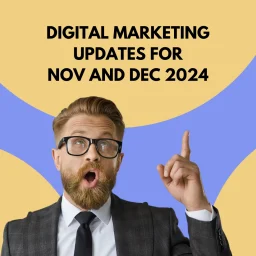The likelihood is, that when I ask you to think about marketing, your mind will immediately focus on digital channels. Things like social media or paid ads, etc. To be fair, it makes a lot of sense as we’re exposed to a lot more digital marketing than offline marketing these days because of devices like phones, tablets, laptops, etc. However, in the ever-evolving world of marketing, there’s a fundamental truth that aspiring marketers should grasp from the outset: a comprehensive understanding of both offline and online marketing is vitally important. If you are contemplating a career in marketing, the importance of developing your knowledge of marketing as a whole cannot be understated. Having a comprehensive understanding of both on and offline marketing ultimately makes you a more versatile marketer. Though you may eventually specialise in a single or selection of areas, having that understanding and if possible, experience, can put you well ahead of your competition.
Back to basics: What is marketing?
Marketing is the strategic process of promoting products or services to target audiences, aiming to satisfy consumer needs while achieving organisational goals. It involves market research, product development, pricing, distribution, and promotion through various channels to create value, build brand awareness, and drive customer engagement and loyalty.
In essence, it’s about connecting with people, understanding their needs, and effectively communicating the value of products or services.
What do we mean by offline marketing?
Traditional marketing channels, such as print ads, TV commercials, radio spots, and direct mail, have long been pillars of marketing campaigns. While digital marketing has gained prominence in recent years, offline strategies still hold considerable value, particularly in reaching certain demographics or creating memorable brand experiences. Unfortunately, they are often perceived as being less “sexy” compared to their digital cousins.
Understanding offline marketing involves grasping concepts like branding, storytelling, event marketing, and public relations. These strategies are often tactile and immersive, relying on physical interactions to leave a lasting impression on consumers. By learning about offline marketing, you will gain a holistic view of the discipline and can integrate traditional tactics with modern approaches for maximum impact.
Again, going back to the start of this article. Think about the amount of digital marketing that we see every day. Digital marketing has become a white noise in the background of our lives. The reality is that it is now much more difficult to stand out in the digital landscape than it was twenty years ago. So, as marketers, we must consider and utilise traditional marketing methods in alignment with these digital channels to create memorable and lasting impressions with our audiences.
So online marketing is…
This being said online marketing is still indispensable. From social media advertising and email marketing to search engine optimization (SEO) and content marketing, the online landscape offers a myriad of opportunities to engage with audiences, build brand awareness, and drive conversions.
Proficiency in online marketing entails familiarity with digital platforms, analytics tools, and emerging trends. As technology continues to reshape consumer behaviour and communication channels, you’ll have to stay abreast of digital innovations and adapt your strategies accordingly.
The importance of understanding the principles of marketing
Understanding the principles of marketing and the use of both online and offline marketing methods is crucial for individuals new to marketing for several reasons.
Firstly, grasping marketing principles provides a solid foundation for developing effective strategies to promote products or services. It enables you to comprehend consumer behaviour, market segmentation, targeting, and positioning, essential elements in crafting compelling marketing campaigns.
Secondly, with the adoption of digital technologies, knowledge of online marketing methods is vital. Online channels offer opportunities to reach target audiences, engage with customers, and measure campaign effectiveness through data. Familiarity with social media marketing, content marketing, search engine optimization (SEO), and email marketing is vital for using these platforms efficiently.
However, offline marketing methods remain relevant, particularly for businesses targeting local markets or niche demographics. Understanding traditional marketing avenues such as print media, television advertising, direct mail, and event marketing allows marketers to create integrated campaigns that connect with diverse audiences and maximise brand exposure.
By mastering both online and offline marketing methods, individuals can adapt to evolving consumer trends and technological advancements, ensuring they remain competitive in today’s dynamic marketplace and effectively drive business growth.
The Marketing Mix, or, as most people call it, the 4Ps
The marketing mix, often referred to as the 4Ps, is a foundational concept in marketing strategy that outlines the key elements a business must consider when crafting its marketing approach. These elements are Product, Price, Place, and Promotion.
- Product – This refers to the tangible or intangible offering that fulfils a consumer’s needs or wants. This doesn’t just mean the physical item but also its features, design, branding, packaging, and any associated services.
- Price –This reflects the monetary value assigned to the product or service. Pricing decisions are influenced by factors such as production costs, competition, perceived value, and consumer demand. Pricing strategies can range from penetration pricing to skimming, depending on market conditions and business objectives.
- Place – Also known as distribution, this refers to the channels and methods used to make the product available to consumers. It involves decisions related to distribution channels, logistics, inventory management, and retail or online presence, ensuring convenient access for target customers.
- Promotion – This involves the various tactics used to communicate with and persuade target customers. It includes advertising, sales promotion, public relations, direct marketing, and personal selling. Promotion aims to raise awareness, stimulate demand, and differentiate the product from competitors.
Together, the 4Ps of the marketing mix provide a framework for businesses to effectively address the key aspects of their marketing strategy, aligning product offerings with consumer needs, competitive dynamics, and market conditions to achieve organisational goals.
What about the promotional mix?
The promotional mix encompasses various communication tools used to inform, persuade, and remind your target audiences about a product or service. It consists of:
- advertising, which utilises paid media channels to reach mass audiences;
- sales promotion, offering incentives to stimulate immediate sales;
- public relations, managing the brand’s image through media exposure;
- personal selling, involving direct interaction between sales representatives and customers;
- and direct marketing, reaching individuals directly through channels like email or direct mail.
Each element plays a distinct role in the marketing strategy, working together to create a cohesive and effective promotional campaign.
Integration is crucially important!
As marketers, we used the phrase “integrated campaigns”. Put simply, integrated marketing campaigns combine both online and offline marketing methods, using the strengths of each to create comprehensive and more effective campaigns. By reaching audiences through multiple touchpoints and channels, we can increase brand visibility, enhance message consistency, and engage consumers across various platforms. This multi-channel presence maximises audience reach and interaction, leading to greater brand recognition and customer engagement.
Integrated campaigns allow for synergies between online and offline efforts, reinforcing messaging and driving conversions more effectively than strategies that rely solely on one channel.
An example…
A beverage company launches an integrated marketing campaign to promote its new energy drink. They utilise both online and offline channels: online, they engage with consumers through social media ads, influencer partnerships, and email campaigns, driving traffic to their website; offline, they organise experiential events, sponsor sports competitions, and distribute samples at local stores. By combining digital and traditional methods, they maximise brand exposure, engage with diverse audiences, and create a memorable brand experience. This integrated approach ensures consistent messaging across channels, leading to increased brand awareness, customer engagement, and ultimately, higher sales.

In summary
Understanding marketing principles and utilising both online and offline methods in campaigns is critical for marketers. While digital channels dominate, understanding and using traditional methods is essential. Integrated campaigns combining both online and offline tactics enhance brand visibility, message consistency, and audience engagement. This approach maximises reach, reinforces messaging, and drives conversions more effectively, ensuring marketers stay competitive and adaptable in the evolving marketing landscape. For this reason, it’s important that when you’re starting out in marketing, although you may be immediately drawn towards digital channels, be sure to learn and gain experience in the offline side of marketing as well. Doing so will give you not only a more comprehensive understanding of the integration between the channels but also make you a more well-rounded marketer.
Interested in seeing more of our guides, advice, and articles on marketing apprenticeships?
Then sign up for our monthly newsletter. We’ll send you all the information on our latest stuff and general updates as well. Sign up below!

















